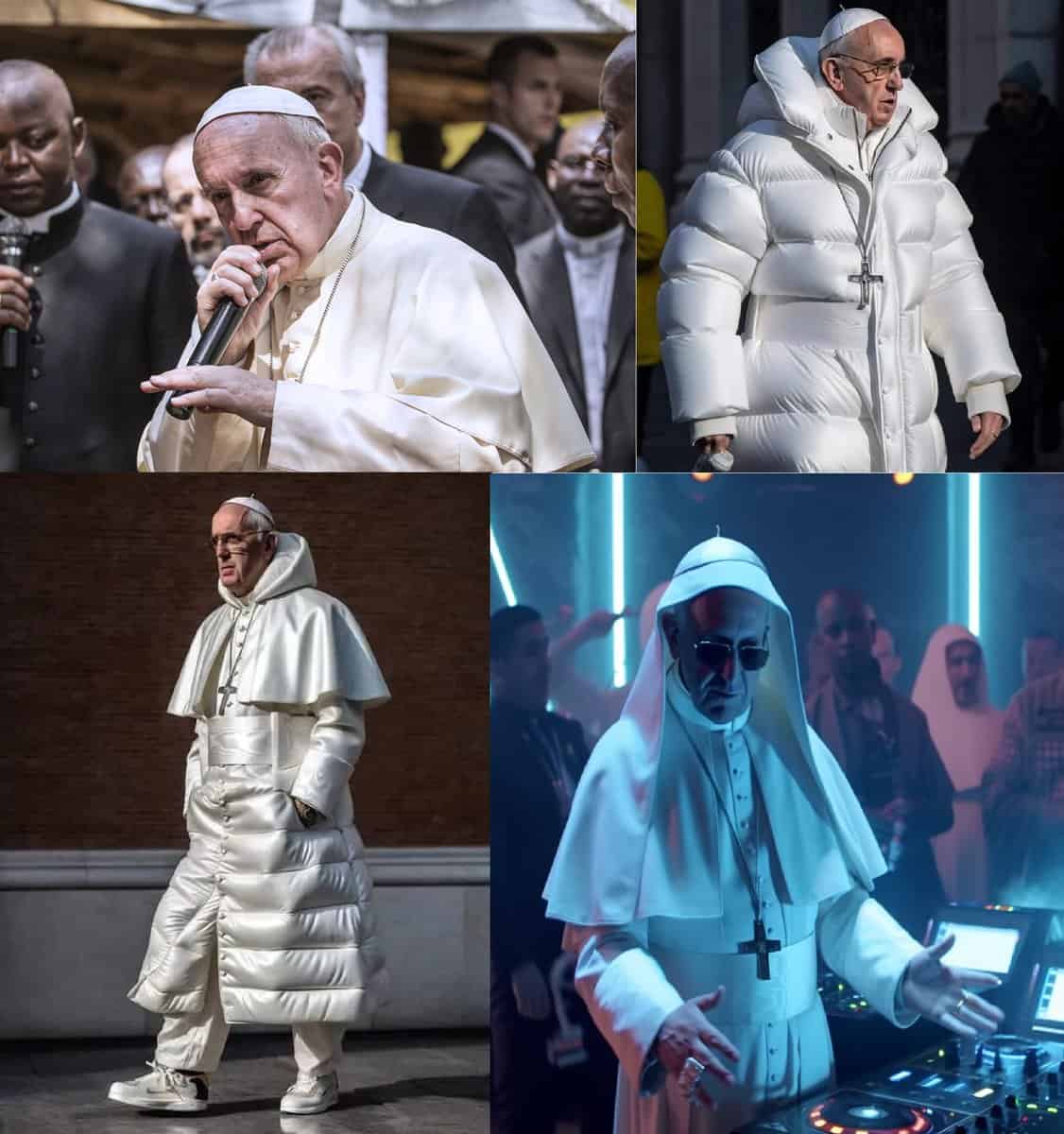If we’re not already transfixed by the power of ChatGPT, the past few days have shown the power of the parallel rise of AI image generators. A viral image of former President Donald Trump made the rounds, followed by an image of Pope Francis in a puffer jacket. These instances mark the onset of an impending deluge of counterfeit AI imagery that will engulf the internet, generating unpredictable political, economic, and social repercussions.
The fake images may have seemed like a cool party trick, and in this instance, they were. But fake images possess the potential to amplify the dissemination of disinformation that will have severe political and social consequences.
If you thought the “fake news” problem couldn’t get any worse, time to buckle up.
The Pope Looks “Dope” In A Puffer Jacket
The fake images of Pope Francis started innocuously enough. Hyperallergic describes how they materialized:
An AI-generated image series depicting Pope Francis in a white puffer jacket went viral on social media over the weekend, spawning a myriad of nicknames including Dope Francis, Pope Smoke, and Pontiflex. The image set was originally posted to the r/midjourney subreddit but gained traction when an unrelated Twitter user posted one of the images without context, effectively tricking enough people into thinking that the Pope was strolling through the Vatican looking like the Michelin Man in real time. . .
A Reddit user who goes bytrippy_art_special shared their Midjourney creations in a r/midjourney post titled “The Pope Drip” just as the weekend kicked off. The account has since been suspended and the post’s comments section has been locked. (A spokesperson for Reddit confirmed to Hyperallergic that the account’s suspension was unrelated to the “Pope Drip” post.)
Mexico-based content creator Leonardo Alpuche (@skyferrori) tweeted the first image of the Pope in the jacket as a joke. He told Hyperallergic he found it funny and noticed that no one had shared it on the platform yet.

For a joke, the images and the ones of Trump’s arrest got a lot of traction. As for the Pope’s new look, it didn’t take long for people to catch on that the image wasn’t real. If you looked closely, there were several clues that it was AI-generated, from the rudimentary rendering of the crucifix pendant on his chain to his eyeglass lenses.
Spotting the fake Pope image was easy if you were a careful observer. But the main issue here is that this isn’t about learning how to spot fake images. As AI-driven image generators, such as Midjourney, continue to advance, distinguishing between authentic and fabricated visuals will become increasingly difficult, if not impossible.
Trump Arrested? Putin Goes to Jail?
The political implications of the use of AI image generators are immense. The fake images of Pope Francis were preceded last week by fake images of Putin and Trump being arrested. The Trump one, generated with Midjourney, was especially striking as it appeared he was being forcibly detained by New York City police.

According to SeattlePi,
In one widely-circulating Twitter thread, Eliot Higgins, founder of Bellingcat, a Netherlands-based investigative journalism collective, used the latest version of the tool to conjure up scores of dramatic images of Trump’s fictional arrest.
The visuals, which have been shared and liked tens of thousands of times, showed a crowd of uniformed officers grabbing the Republican billionaire and violently pulling him down onto the pavement.
Higgins, who was also behind a set of images of Putin being arrested, put on trial and then imprisoned, says he posted the images with no ill intent. He even stated clearly in his Twitter thread that the images were AI-generated.
Higgins notes that with inauthentic content, you need to examine the evidence and “triangulate it against other information.” But it’s a “. . .time consuming process, and that’s the problem in terms of it being shared as information.” It’s even more challenging with fake images as there may be nothing to triangulate them against – except, perhaps, alternative images.
Which could also have been faked.
Digital Literacy Isn’t The Answer to AI-Generated Fake Images
At present, no comprehensive solutions exist to counter the challenges presented by AI image generators like Midjourney. While the current generation of synthesized images may exhibit imperfections—as demonstrated by the counterfeit Pope image—their quality has significantly improved with the recent release of an updated version of Midjourney. This cutting-edge text-to-image synthesis model generates persuasive visuals, complete with backgrounds, that rival the quality of authentic news agency photographs.
As The Verge put it, the Pope and his stylish Balenciaga gear going viral was,
. . . both scary and reassuring, because it suggests there is currently a limit to what AI fakes are believable but scary because this technology is moving too fast for any current reassurances to hold true for long.
Ryan Broderick on Twitter put it more succinctly,
I think Balenciaga pope might be the first real mass-level AI misinformation case.
I can assure you it won’t be the last.
Don’t Expect A Quick Solution
Of course, we’ve had deep-faked images and videos for years, but you could usually tell the difference. And up to now, you could always argue – as many academics did – that better digital and media literacy would be a safeguard. But literacy only works when you have something to be literate about, and now the fake image is becoming indistinguishable from the real.
Moreover, prior to the advent of the AI revolution, creating convincing fake images was a more challenging endeavor. It typically necessitated proficiency in tools like Photoshop. In contrast, platforms such as Midjourney and ChatGPT rely on textual prompts, radically simplifying the process. Now, users only need to articulate their desired image, making it more accessible than ever to generate realistic yet fabricated visuals.
Agnes Venema, at the University of Malta, sums up the challenge as one of scale and quality,
I think the fact that so many people can now access it – in a way, it is more democratic – means that, in a way, the floodgates have opened. The more realistic it gets and the more people gain access, the more careful we should be and the more risk there is of someone acting on this type of deception.
As Jevin West, a professor at the University of Washington in Seattle, notes, the result is that AI-generated images will increase our cynicism.
You start to lose trust in the system and the information that you are getting.
Yet, West’s observation doesn’t fully capture the gravity of the situation. When it becomes virtually impossible to distinguish reality from fabrication, trust will be entirely eroded. In the best-case scenario, everything loses significance; in the worst, we succumb to deception, echoing one of Morpheus’ options from the first Matrix movie:
This is your last chance. After this, there is no turning back. You take the blue pill, the story ends, you wake up in your bed and believe whatever you want to believe.
One potential solution could involve AI-driven detection systems, but organizations like OpenAI have made limited progress thus far. Alternatively, regulatory measures could be implemented to curb the dissemination of falsified images. However, this raises the question of who should determine the bounds of online content. Putin has already banned fake news in Russia, and you can imagine how that’s going.
Perhaps there is a red pill alternative, as Morpheus put it so compellingly,
You take the red pill, you stay in wonderland, and I show you how deep the rabbit hole goes.
But at the moment, there is no red pill in Morpheus’ other hand, no alternative solution. We can laugh at the Pope’s puffer jacket now – and it honestly rocks as an image – but we may not laugh in another year.
We’d love to hear your thoughts about where we’re headed.
Emory Craig is a writer, speaker, and consultant specializing in virtual reality (VR) and generative AI. With a rich background in art, new media, and higher education, he is a sought-after speaker at international conferences. Emory shares unique insights on innovation and collaborates with universities, nonprofits, businesses, and international organizations to develop transformative initiatives in XR, GenAI, and digital ethics. Passionate about harnessing the potential of cutting-edge technologies, he explores the ethical ramifications of blending the real with the virtual, sparking meaningful conversations about the future of human experience in an increasingly interconnected world.

